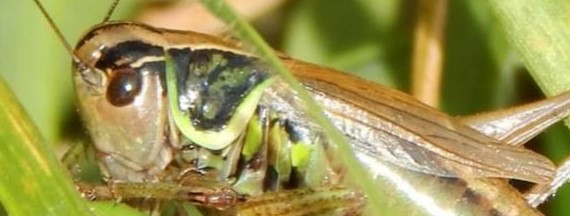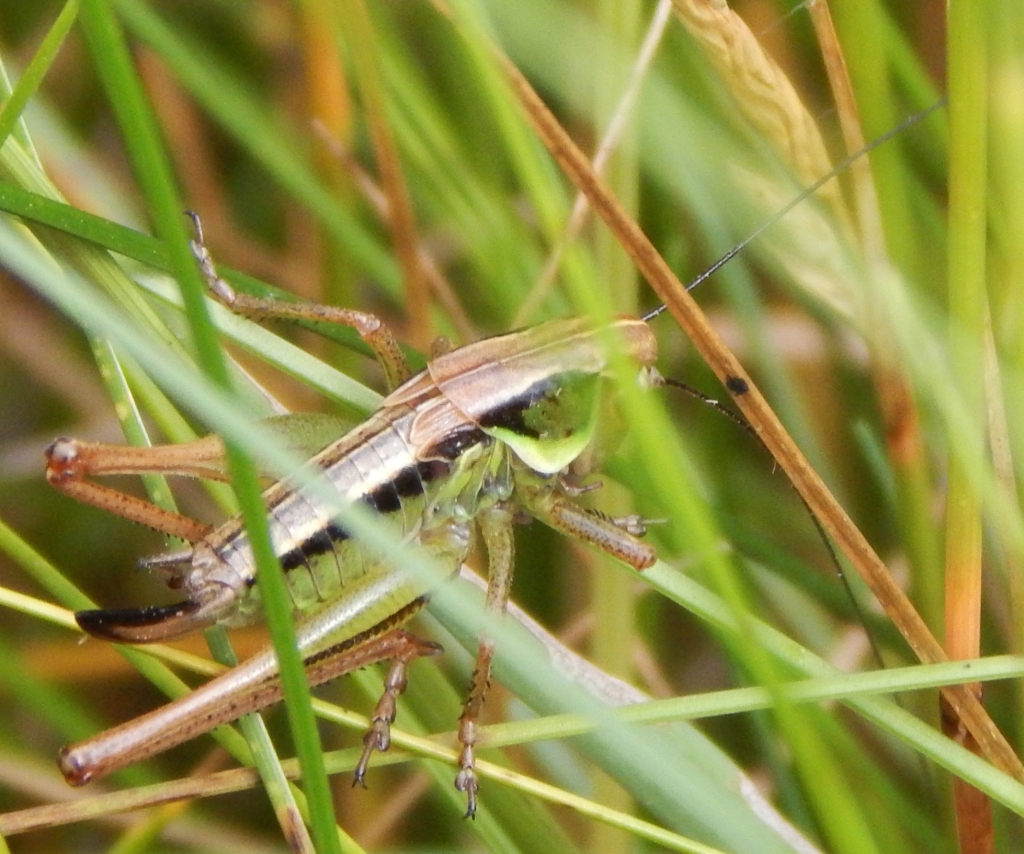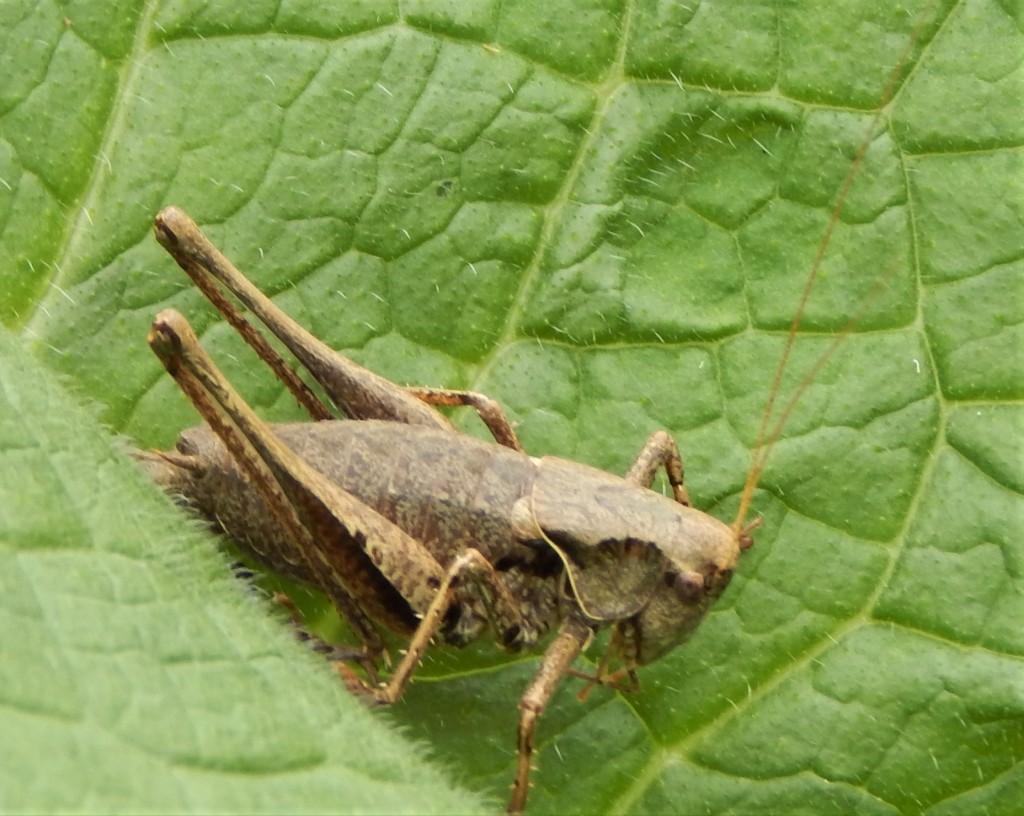
[303] Roeseliana roeselii, Roesel’s Bush-cricket
Introduction
August Johann Rösel von Rosenhof was a German entomologist who gave his name to this species, Roeseliana roeselii, Roesel’s Bush-cricket, which is easily distinguishable from other bush-crickets found in the UK.
All insects in the family Tettigoniidae are known as Bush-crickets, except in North America and South Africa where they are called Katydids. (They used to be called Long-horned Grasshoppers.)
Taxonomy
Kingdom – Animals
Phylum – Arthropods
Class – Insects
Order – Orthoptera (Grasshoppers, Locusts and Crickets)
Suborder – Ensifera (Crickets)
Superfamily – Tettigonioidea (Single family)
Family – Tettigoniidae (Bush-crickets or Katydids)
Subfamily – Tettigoniinae
Tribe – Platycleidini
Genus – Roeseliana
Scientific Name – Roeseliana roeselii
It retains the synonym Metrioptera roeselii.
Name
Cricket comes from a diminutive of the Old French criquer, coming from their sound, cognate with crack or creak. I don’t know why bush crickets are called bush crickets (or bush-crickets.) Katydids derive their name onomatopaeically from the sound of one species, Pterophylla camelifolia, the Common True Katydid.
Like the Cetti’s Warbler, Cettia cetti, this insect manages to derive its common name, genus and species epithet all from the same person.
(Sorry, Cetti’s Warbler didn’t make it. It’s fairly common locally and there are several places where I almost always hear its familiar call. But, like the Nightingale, it is much, much more often heard than seen.)
Transliteration
By way of a short diversion, I need to say something about orthography, which is a really posh word for spelling. To be precise I am going to talk about transliteration, which relates to using the standard ‘English’ alphabet to represent words written in other languages. Greek uses a different alphabet; Russian uses a different alphabet; and Chinese and Japanese use more complex pictorial syllabic letter systems.
We represent Greek words by changing each Greek letter to an English letter – but sometimes we have to use two. Here are some examples,
- δ (Delta) becomes ‘d’
- λ (Lamda) becomes ‘l’
- φ (Phi) becomes ‘ph’
- ψ (Psi) becomes ‘ps’
- θ (Theta) becomes ‘th’
- υ (Upsilon) becomes either ‘u’ or ‘y’ [It’s a long story. Both letters have come from Upsilon.]
Just in case you think Latin has no problems, remember that Latin was written in upper-case only, with no punctuation or spaces between words. And the letters J and U did not exist to the Romans.
- I becomes either ‘I’ or ‘J’
- V becomes either ‘U’ or ‘V’
See [060] Buddleja.
I won’t go into the Cyrillic alphabet used for Russian but it has its own letters that become shch, ts, ya, yu and several others.
The Chinese system is more complex because we avoid the Chinese writing altogether and use systems to write the sounds of spoken Chinese. The now obsolete Wade-Giles system was replaced by Hanyu Pinyin fifty or more years ago. It is hard for Western people to understand that when the capital of China changed from Peking to Beijing it was not a change to the name, or the way it is pronounced in Chinese. It was just a change in the way we try to write the sounds of Chinese. See [025] Hubei Anemone.
I know you are wondering what this has to do with bush-crickets! Well, even modern European languages have their quirks. Some have various accents and the German language has umlauts, which are double dots over some vowels. In German, ‘ӧ’ is not pronounced the same way as ‘o’ and we generally maintain the difference. The standard way in English (which is also the way in German when the letter ‘ӧ’ is not available,) is to replace ‘ӧ’ with ‘oe.’ That’s why Rӧsel became Roesel.
Roesel
I know you are all want to know about August Johann Rösel von Rosenhof. He is described as a painter of miniatures, a naturalist and an entomologist.
At birth (near Arnstadt in Germany) he was named August Johann Rösel. His father died when he was very young and his godmother Princess Augusta Dorothea von Arnstadt-Schwarzburg saw that he was a talented artist. So, his uncle Wilhelm Rösel von Rosenhof gave him an artistic education that continued at the Academy of Nurenberg. He became a renowned painter of portraits and miniatures.
A few years later he discovered the work of Anna Maria Sibylla Merian, Metamorphosis insectorum Surinamensium in which she described the insects and other animals which she observed in Surinam. He decided to write and illustrate a similar book on the German fauna.
He lived comfortably by painting and used his spare time to observe insects, amphibians and reptiles. He collected eggs and larvae in order to raise them at home and to study their development and metamorphoses.
His detailed observations, accompanied by beautiful illustrations, were published in two large books. The first, Insecten-Belustigung, appeared in 1740, devoted to insects and other invertebrates like the sea anemones. His classification of the insects followed a natural system and he is regarded as one of the fathers of German entomology. He included a detailed study of [030] Araneus diadematus.
He published, between 1753 and 1758, Historia naturalis Ranarum nostratium devoted to frogs. He then started a similar work on the lizards and the salamanders but a cerebral attack paralysed him and he died a little later on March 27, 1759. Many descriptions of species made by Carl von Linné (generally known as Linnaeus) are based on the descriptions given by Rösel.
It was not until 1753 that he added von Rosenhof to his name in honour of his uncle.
It is unlikely that he had any particular association with the insect named after him, other than his general interest in entomology.
Bush-crickets
To most people almost all of the species of Orthoptera would be called just grasshoppers but entomologists like to divide the order into two suborders Caelifera and Ensifera. Until fairly recently these were called Short-horn Grasshoppers and Long-horn Grasshoppers. Now insects within Ensifera are called Crickets. Roughly half of the species of Ensifera are true crickets and half come in the family Tettigoniidae, Bush-crickets.
Of over 6 000 species of bush-crickets worldwide, about a dozen may be found in the UK including [201] the Speckled Bush-cricket.
Description
Roesel-s Bush-crickets can be brown or yellow or sometimes greenish. They are recognizable by the light yellowish margin to the pronutum (the visible part of the thorax, roughly where animals might have shoulders.)



You can see, in the first two pictures above, the long, curved ovipositor of a female Bush-cricket that gives them the name Ensifera, ‘sword-bearer.’
They have one generation per year, Nymphs emerge in May and go through five or six instars. Adults emerge from June to July, sometimes a bit later. They disperse by walking through grasses and ditches
It usually has only vestigial wings but occasionally winged ones can emerge, allowing the insects to spread more easily.
Habitat
Its range covers central and southern Europe and parts of northern Europe. It is one of the most common species of Orthoptera found in the UK. Originally common in saltmarshes and around estuaries it is now common in urban wasteland
Like most grasshoppers and crickets, they live in grasses, eating grass seeds and smaller insects.
Other Notes
In many ways Bush-crickets are similar to [078] Grasshoppers. You won’t see them unless you search the grass at your feet. If you do see one, it may jump to somewhere you can’t see it. Generally, they don’t fly.
Apart from Roesel’s, the UK species are not easy to tell apart from each other
See also
Here is a Dark Bush-cricket, Pholidoptera griseoaptera

It is fairly common over Britain and found over most of Europe. Females are virtually wingless and males have very small wings. Winged forms are never seen.
